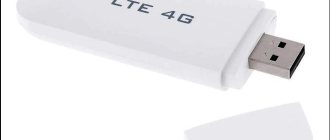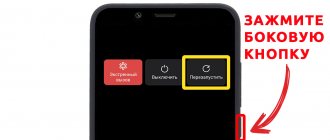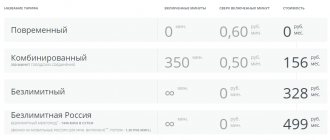Internet on your phone is drawing more and more money? Popular mobile operators have interesting tariff plans that allow you to use the Internet relatively inexpensively, communicate online or with subscribers of other operators, and even maintain communication while roaming. The rating includes the best tariffs for the main areas of use of mobile services.
How the tests were carried out
We measured speeds throughout Moscow at the beginning of March.
We used iPhone 11 for the Russian market with the current firmware at that time. We had 4 operator SIM cards on hand: MTS, MegaFon, Beeline and Tele2.
We inserted them one after another, waited for the network to be fully activated, then opened the Speedtest application from OOKLA and did 3 tests in a row with a short pause. This was necessary to exclude abnormal results.
We recorded the best one and then entered it into a table , divided by operators and locations.
These results resulted in an interactive map on Yandex with colored dots indicating the leading operator. By clicking on each one, you will see detailed statistics.
Once a week we published articles with the results:
– train stations and airports in Moscow and the region – shopping centers in Moscow – Moscow metro – Moscow sights
There were 29 points.
The best tariff plans with a large amount of traffic
Sometimes even a large traffic package is not enough? It is worth using tariff plans with completely or almost unlimited Internet.
TELE2 “INTERNET TO TABLET”
Inexpensive tariff plan with limited Internet (15 GB of traffic). But you can absolutely unlimitedly use the main social networks, the proprietary Tele 2 application and navigation programs. This is one of the few operators that transfer remaining traffic from last month to the next reporting period absolutely free of charge. 500 rubles is the highest rate in force in Moscow. In the regions the price is about 300 rubles.
Price: 500 rubles.
Tele2 “My Unlimited”
This is a budget tariff plan for people who constantly use the Internet. In addition to unlimited traffic, it provides 500 free minutes for calls between all Russian operators. Even a small number of SMS (50 pieces) is not too upsetting, given that you can almost always use the messenger. The cost of the Moscow tariff is 650 rubles, but in St. Petersburg it costs 510 rubles, and in Samara – 400 rubles. The operator also offers the service of sharing available gigabytes between other Tele2 users.
Price: 650 rubles.
Beeline "Unlim"
In terms of price ratio and available bonuses, the tariff is one of the best. It provides unlimited Internet, 600 free minutes for all operators and 300 SMS per month. With the “Delhi Gigi” option for 150 rubles, it is possible to transfer up to 15 GB of endless Internet to another user. This is a good opportunity to save on the tariff for another family member. Beeline offers web surfing not for show; the Internet is really fast and allows you to watch high-resolution videos in real time.
Price: 690 rubles.
MTS Tariffishche
One of the most attractive tariffs in Russia, which offers the purchase “in bulk” of large volumes of minutes, SMS (500-3000) and other services. Regardless of other purchases, the operator provides access to unlimited Internet. A nice bonus is a gift in the form of a subscription to IVI if you purchase 1500 or 3000 minutes. There is one way to save on paying for a tariff plan - connect the “MTS TV Application + Tariffishche”, which will cost 790 rubles. In this case, the user will have access to 4 online cinemas, 60 TV channels and TV series from FOX NOW.
Price: 1500 rubles.
What results did you, readers, predict?
From the first article, a survey was launched: which operator will ultimately demonstrate the highest average speed? His results:
1. MegaFon, 62% 2. MTS, 21% 3. Tele2, 9% 4. Beeline, 8%
The survey was interesting to us as an indicator of subscriber expectations. MegaFon's first place is predictable: the operator actively praised itself last year, and previous results of nationwide testing - be it our own or the global one from OOKLA - ultimately called the “green” ones the fastest.
MTS, as the largest operator by number of subscribers, became second in the national standings. Tele2 and Beeline turned out to be outsiders in this survey.
The third place is Tele2, which has no confirmation of the reality of Russian mobile Internet speeds. Both last year and now it was the “slowest” operator in Moscow. Beeline compared to it... well, now see for yourself.
Tele2 packages
This operator has developed competitive tariffs, much cheaper than others. The only drawback is that coverage is only available in large regional centers, although it is growing rapidly every year. Users are offered 5 basic tariffs:
- “Everywhere Online” - 40 GB, unlimited traffic in social networks and instant messengers, 500 minutes and 50 SMS for 450 rubles/month;
- “Everywhere Online+” - 80 GB, free online calls for 600 minutes to other numbers for 540 rubles;
- “My Online” - 15 GB, free online conversations, 500 minutes and unlimited use of social networks and instant messengers for 360 rubles/month;
- “My Conversation” - 4 GB, unlimited calls over the network and 200 minutes for 225 rubles/month;
It is also possible to connect only the Internet to the phone:
- 1 GB - 120 rubles/month;
- 3 GB – 200 rub/month;
- 15 GB – 400 rub/month;
- 25 GB – 600 rub/month;
- 40 GB – 900 rub/month.
If you need a lot of traffic, then the latest tariff is the most profitable, but keep in mind that calls and SMS are quite expensive (1.8 rubles for Tele2 numbers and 10 rubles for other operators for 1 minute). You can connect packages here.
What happened in the end? Who became the fastest operator in Moscow
Average speeds of operators in Moscow, March 2021, iPhones.ru test
Based on the number of best results, MegaFon won :
1. MegaFon, 17 points 2. Beeline, 7 points 3. MTS, 5 points 4. Tele2, 0 points
Beeline took second place instead of MTS, so the readers made a mistake here. There is nothing to say about Tele2.
MegaFon won in terms of average speed :
◾ MegaFon: 75.6 Mbit/s ◾ Beeline: 40 Mbit/s ◾ MTS: 34.9 Mbit/s ◾ Tele2: 16.7 Mbit/s
Here again a similar picture. With MegaFon everything is clear. But Beeline’s second place was an unexpected result that contradicted both our expectations and yours. You gave him the last place.
In general, congratulations to the “greens”.
I emphasize that these results reflect specifically our test, which was limited to 29 points in the capital and its surrounding region. We would be happy to collect at least a thousand more points. This would require testing for several months. And, okay, but we had to stop, since self-isolation began in the country at the end of March.
"MTS"
The well-known telecom operator with a red and white logo does not lag behind its colleagues. A unique offer - add an option for 100 rubles and connect one Internet to five devices. This is convenient for owners of smartphones and tablet computers.
Internet package offers are divided into three types: mini, maxi, VIP. The mini kit includes 8 GB of traffic for 350 rubles per month. For the Maxi package you will have to pay 700 rubles and get a volume of 15 GB plus unlimited use of the network at night. In addition, free use of cloud storage and the purchase of additional traffic if necessary are offered.
What speed can you expect on average in Moscow?
48.88 Mbps.
This is if you don’t look at specific operators and just calculate the average value for all results.
For comparison, last year the average download speed in Moscow was 31.4 Mbit/sec .
The best roaming rates
Frequent travel abroad forces you to either pay dearly for communications on a permanent card, or buy a SIM from a local operator and lose contacts with friends from home. This can be avoided with the following tariffs.
Tele2 "Premium"
One of the most expensive tariffs from the operator, which includes 50 GB of traffic, 500 SMS and 2000 minutes within Russia, regardless of the operator. It cannot be called aimed exclusively at roaming, so calls and SMS will be made at standard rates. But the package includes the option of unlimited Internet outside the country. The only limitation is that abroad the normal speed will be maintained only for the first 200 MB per day, then it decreases to 128 Kbps.
Price: 1500 rubles.
Beeline “All for 1800 + roaming”
The tariff from Beeline is distinguished by a successful combination of roaming and home services. It can be connected for just 1 month and used in more than 100 countries of the world, including almost all resorts and popular tourist destinations. The price for services in all regions is fixed. The tariff plan includes free incoming calls abroad, 3000 minutes, 3000 SMS and 15 GB of traffic. Calls within the network are not limited.
Price: 1800 rubles.
Again about online application generators
In the previous article in this series, we discussed creating applications for the Android platform using Java and Android Development Tools (ADT). Today we will continue this topic by getting acquainted with a new product from Embarcadero - RAD Studio XE 5. Essentially, this product is a modern incarnation of Delphi, a Windows application development tool that has been incredibly popular in our country for many years, starting from the first 16 bit version, which appeared in the second half of the 1990s. But, unlike Delphi of the late 1990s and early 2000s, RAD Studio XE 5 is a tool that allows you to create applications not only for Windows, but also for Mac OS, Android, iOS, and, importantly, based on one and the same source code and resources - having created an application project, you can simply compile the executable code for any of the named platforms. Development of mobile applications is possible using the Architect, Ultimate, Enterprise editions, as well as the Professional edition, provided that the Mobile Add-On Pack extension module is purchased with it. The development environment itself is available only for the Windows platform. If desired, in RAD Studio XE 5 you can develop in C++Builder, as well as create HTML-5 applications.
This publication cannot be considered a traditional product review - like all articles in this series, it gives an idea of the tool by describing the process of creating a mobile application with minimal effort.
You can get started with RAD Studio XE 5 by downloading a 30-day trial from Embarcadero (available for various versions of Windows). The product installation process is carried out directly from the manufacturer’s website, so it is worth doing this by ensuring that you have a reliable and not too slow Internet connection.
After installing RAD Studio XE 5 itself, you should take care of installing support tools for the platforms for which you intend to create the application. So, to develop applications for the Android platform, we need the Android SDK, already familiar to us from the previous article, with support for selected versions of the platform - it can be installed by launching the Android Tools application included with RAD Studio XE 5 (Fig. 1).
Rice. 1. Selecting an application for modification
If the application is to be tested on a real device, its driver should be installed on the computer with the development environment (usually it can be found either on the device manufacturer’s website or on the Google website). On the device itself, you should enable remote debugging of applications in the settings.
To develop iOS applications, you will need a computer running Mac OS X to run the emulator. If you don’t have the latter, you can use Embarcadero’s MacinCloud cloud service, which also has a trial period of 24 hours. To test iOS applications on mobile devices and then upload them to the AppStore, you should also join the Apple iOS Developer Program or a similar program for universities or corporate clients.
The development environment itself looks quite traditional (Fig. 2) - a project manager (Project Manager, top right), a component palette with groups of interface elements and so-called non-visual components (Tool Palette, bottom right), a tree with the structure of form components (Structure, left top), Object Inspector (bottom left), form and code editor (center).
Rice. 2. Replacing the application logo
We will begin creating our very first application (as always, dedicated to introducing ComputerPress magazine) by using a ready-made template. To do this, in the main menu of the development environment, select the item File->New->FireMonkey Mobile Application and, among the proposed application templates, select the element Tabbed with Navigation (Fig. 3).
Rice. 3. Editing buttons
As a result, an application project will be generated, similar to the one the creation of which was described in the previous article of this series, and which is a notepad with four tabs, on each of which you can further place interface elements (Fig. 4).
Rice. 4. Setting the functionality of the buttons
By selecting a potential platform for running an application in the upper right corner of the form editor, you can see how it will look when executed on a particular platform.
Next, by selecting interface elements with the mouse (in our case, labels and tab titles), we can change the labels on them using the Text property in the object inspector.
For iOS applications, using the StyleLookup property, you can also select icons placed on notepad shortcuts (Fig. 5).
Fig.5. Widgets available for selection
The next step in creating our application is to add interface elements to the notepad tabs. To do this, click on the “About the Journal” tab, select the TMemo component in the Standard group on the component palette (Delphi users are familiar with it, but for beginners I’ll tell you that it’s just a multi-line text editor) and place it on the form. Let's find the Strings property in the object inspector, click on the button with the ellipsis and copy the brief information about our journal borrowed from our website www.compress.ru into the property editor that opens. From the list of possible values for the Align property of our Memo1 component, we select the value alClient - in this case, our text editor will occupy the entire area of the screen between the title and labels. And finally, we will set the Enabled property of this component to False so that the user of our application cannot edit the text (Fig. 6).
Rice. 6. Publish the application for testing
Let’s repeat all the same steps with the “Categories” tab, placing in the created Memo2 component the text borrowed from the same website about the magazine’s headings.
Next, let's give our application some variety - on the next two tabs we will place not a text editor, but a browser - the TWebBrowser component (it can be found in the Internet group of the component palette). Let's change the Align property of these components to the alClient value. Next, fill in their URL properties. For the component on the “Our Site” tab, enter https://www.compress.ru as the value of this property, and for the TWebBrowser component on the “Coordinates” tab, enter a link to the Yandex.Maps server, which will indicate the search result for the building editorial office on the map of Moscow. Then save the project.
So far, our application has certain disadvantages: for example, it does not have the ability to return to the previous page in browsers on the third and fourth tabs. Let's correct this shortcoming. To do this, at the top of one of the browser tabs, we will place two TSpeedButton buttons, linking one of them to the upper left and the other to the upper right corner by selecting the options akTop, akLeft, akRight of the Anchors property of each button and adding arrow images to them using the already familiar StyleLookup property (Fig. 7).
Rice. 7. Finished application - iPhone 5 screenshots
Let's double-click on each of the buttons, after which empty event handlers associated with clicking on them will be generated. Let's add one line of code to them (highlighted in bold):
procedure TTabbedwithNavigationForm.SpeedButton1Click(Sender: TObject);
begin
WebBrowser1.GoForward;
end;
procedure TTabbedwithNavigationForm.SpeedButton2Click(Sender: TObject);
begin
WebBrowser1.GoBack;
end;
These two lines of code mean that when you click on one of the buttons, you move to the previous page that opened in the browser, and when you click on the second button, you move to the next one.
And finally, select both buttons, copy them to the clipboard, go to the tab with the second browser and remove them from the clipboard. If you do this carefully, the buttons will be copied along with their properties and event handlers. Let's save the project.
Actually, this will complete the creation of the application. Now it can be compiled and tested. Let's start by compiling the application for the iOS platform. First, you need to connect to a computer with Mac OS X, located on the same network as the Windows computer on which development is carried out, or to the MacinCloud service. In the first case, you also need to install the Platform Assistant console application on a computer running Mac OS X and launch it, and then enter a password to access it in the RAD Studio XE 5 development environment. Then you should describe the connection to this computer by selecting the option in the main menu of the development environment Tools->Options. The Connection Profile Manager section of the Options dialog panel contains a list of connection profiles to which you can add a new profile by specifying the computer name and password to access the running instance of the Platform Assistant application (Figure 8).
Rice. 8. E-book created using the appropriate template
You can test the connection using the Test Connection button. If problems arise, it is worth checking whether the computer running the Platform Assistant application is accessible on the network and whether the port through which the connection between computers is made is open.
After successfully connecting to the Platform Assistant application, in the project manager, select the appropriate platform and the configured connection profile with a computer running Mac OS (Fig. 9).
Rice. 9. Create an iPad application
Select the main menu option Run->Run or press the F9 key. We wait for a while and an iPhone emulator with our application will appear on the screen of a computer running Mac OS X.
Now let's try to compile the same application to run on the Android platform. Let's connect the device used for testing, select the device and platform in the Target Platforms section of the project manager and run the application again using the F9 key.
After a relatively short period of time, our application will launch on the connected device.
So, we have created a cross-platform application that can run on both iOS and Android. At the same time, we did not need to use any special execution environments or code generation with subsequent compilation in development environments like Xcode or Eclipse + ADT - RAD Studio XE 5 creates so-called native applications. This means that the performance of such applications should be comparable to the performance of applications created, for example, using Xcode or ADT.
Miracles, of course, do not happen - the size of executable files created using RAD Studio XE 5 will probably be larger than when using Xcode or ADT. But space on mobile devices, you see, is not the most expensive resource today - investments in the knowledge and skills of mobile application developers will cost much more. And here RAD Studio XE 5 is still out of competition - supporting two of the most popular mobile platforms at once means that there is no need to have separate development teams for iOS and Android. It is also important that companies that decide to implement RAD Studio XE 5 have access to a huge number of Delphi and C++Builder experts of all ages and with a wide variety of experience on the Russian labor market - after all, this tool is, after all, almost 20 years old.
In conclusion, I would like to draw your attention to the fact that the Embarcadero website has a huge amount of educational materials on developing mobile applications using RAD Studio XE 5, and this collection of materials is constantly growing. Therefore, mastering this tool will not be too difficult even for beginners.
The previous two articles in this series were devoted to a brief introduction to professional application development tools using the Android Development Toolkit and a new product from Embarcadero - RAD Studio XE 5. We conclude the topic of professional tools for creating mobile applications, and today we will return to online application generation services , the use of which, as we already know, in some cases can be more effective than independent development using professional tools.
The service that today's article is devoted to is called iBuildApp and is an online application builder for smartphones that does not require any programming skills from the user. It belongs to the American company of the same name with a Russian representative office in Vladimir.
You can create applications using the iBuildApp service for free, and you can (but not necessarily) publish them in online application stores on your own. At the same time, the owners of the service provide users with a number of paid services, such as publishing applications in online stores for those who are not ready to publish on their own, assistance in monetizing applications (that is, making a profit by placing advertising in them), sending push and GPS messages -notifications to application users, 24/7 email support. Payment for services is possible on a monthly basis in accordance with various tariff plans, differing in the number of application downloads and the availability of the services listed above. Moreover, all tariff plans, including the free one, include access to ready-made application templates (including free and paid ones) and built-in components (widgets), technical support, the ability to see application performance statistics and downloads.
Special mention should be made of application templates and ready-made widgets - this service has a lot of them. Templates are available for different types of companies, types of activities, application categories, and you can change design options for a ready-made template and add widgets to it. If you wish, you can create your own templates and widgets and place them in the iBuildApp tools catalog, or order the development of a widget or even an entire application from the owners of this service.
Let's take a look at what you can create with the free plan. Let's start with the ComputerPress application, traditional for our cycle, with information about our magazine. To do this, you need to choose either a template or an almost finished application that can be modified.
From the ready-made applications, we will choose “Small Business” - the editorial offices of magazines for the most part belong to this category of companies (Fig. 1).
After making the selection, we will find ourselves in the application editor, in which, by opening the elements of the list of possible actions sequentially or in random order, we can customize its appearance or functionality, for example, replace the background or logo (Fig. 2).
I would like to draw attention to the support for the Russian application interface and the presence of a Russian interface in the online application editor - now not all such services have even the first of these features.
Next, you can make changes to the number and appearance of buttons, and you can choose your own graphic images for them (Fig. 3).
The button functionality available by default can also be replaced with the desired one. In particular, it is possible to select the necessary widgets from a fairly extensive list and configure their parameters, for example, entering text and pictures in the case of a widget displaying a static HTML document (Fig. 4).
Among the widgets available today are widgets for displaying RSS feeds, HTML documents, interfaces with Twitter and Facebook, video lists from YouTube and Vimeo, interfaces with the phone, email client, Google Map mapping services, contact management tool, calculator, camera, photo gallery, an electronic book, a QR code scanner, free-form input with user-selectable interface elements and many others (Fig. 5).
Users also have the ability to create their own widgets and templates to use in their applications.
Once you have finished building the functionality, you can make the application available for download in accordance with your tariff plan. The free plan offers two ways to publish an app: creating a package for download on an Android device (which means we don't have to publish the app to the Google Play store) and creating an HTML5 app (which means we can test it on a device running iOS, without publishing the application in the AppStore and without purchasing an iOS developer license - Fig. 6).
In Fig. 7 shows screenshots of an iPhone 5 running a ready-made application downloaded from the link above.
Because we're using the free plan, the app includes an iBuildApp splash screen ad that appears when the app loads, an ad line on the title page, and banner ads that appear at the top of other pages when you open them (they can, however, be closed).
“Small Business” is not the only type of application available to users of the iBuildApp service. The range of potential consumers of ready-made applications and templates for this service is very diverse - from cafes and restaurants to religious organizations. For example, an e-book created from the appropriate template looks very good (Fig. 8).
In addition to applications for smartphones, the iBuildApp service also allows you to create applications for iPad. The choice of templates for this type of application is still small, and the finished application can only be tested in a browser (Fig. 9).
In addition to creating applications, the user of the service can create their own application templates (for this there is an online template editor that supports drag-and-drop operations) and sell them, as well as create their own widgets using XCode or Android SDK. But if you don’t want to deal with the issues of form design, purchasing a developer license and using development tools, you can get by with ready-made templates and widgets.
This concludes our acquaintance with the iBuildApp service for quickly generating mobile applications. It differs from similar services in the large number of templates and ready-made applications available for use, full support for the Russian language, not only in the applications created, but also in the online application editor, a very flexible pricing policy and a wide range of features available for free or for a nominal fee. Potential consumers of such a service can be companies and organizations of various profiles: cafes, restaurants, medical institutions, fitness clubs, retail enterprises, electronic stores, educational institutions, publishing houses, online stores, clubs. If such a consumer has a need for a Russian-language mobile application with more or less standard functionality, he should pay attention to this service - its use is highly likely to be much more effective than implementing or ordering individual development.
ComputerPress 12'2013
What to look for when choosing
Before choosing one or another tariff plan, you need to decide on your preferences, namely:
- Understand what volume of traffic will be optimal for you. Each operator has different offers, and the amount of traffic provided varies from 2 GB to unlimited.
- Consider the number of minutes needed for calls. Some operators provide the opportunity to choose a convenient number of minutes.
- Decide on the amount you can allocate each month to pay the tariff. It is worth remembering that the more traffic and minutes you need, the higher the subscription fee.
After such simple steps, you need to study the offers of mobile operators and write down the ones that interest you the most.
Video - Choosing the best mobile operator
The most important principle for choosing the services of a telecom operator is not to overpay them for something that you will not use. So, carefully analyze your needs and offers on the market, compare them and choose the option that is truly beneficial for you. With this approach, you definitely won’t go wrong, you won’t make a mistake, and you’ll be able to choose the most optimal and cheapest cellular tariff for you.
By the way, many operator sales points also sell mobile phones. And if you are suddenly planning to change your smartphone, then here you can read which phone is better to buy in 2021.
Yota
The young operator Yota has today created a separate series of tariffs for the modem. TP "Yota for computer" includes the following connection options:
- 2 hours at maximum speed will cost 50 rubles;
- A subscriber can connect for 1 day at maximum speed for 150 rubles;
- 1 month of Internet is connected at a separate tariff rate.
In the latter case, the payment depends on the selected Internet signal transmission speed. The user will be able to choose a speed convenient for themselves in the range from 64 Kbps to the maximum speed in the 4G network.
SIM card for internet
We offer SIM cards with favorable Internet rates. The best options for modem and Wi-Fi routers are on sale at affordable prices. To order goods in our store, just select the most suitable tariff. We offer to buy SIM cards with unlimited Internet, which will allow you to freely access the network without speed restrictions from a modem or router. By taking advantage of our offer, every user will experience the capabilities of a modern mobile connection.
Beeline
This company offers subscribers a wide range of tariffs for various devices. Users should know which Beeline SIM card is needed for the modem. Today the best offer of this provider is called the “For Computer” tariff.
This package is suitable for working in a modem. It includes the following features:
- 30 GB of traffic;
- connection to the 4G network;
- free access to the global network at night.
This tariff is suitable for comfortable browsing the Internet, communication, and watching videos. Subscribers can choose additional options for connection, which can be found on the official website.











